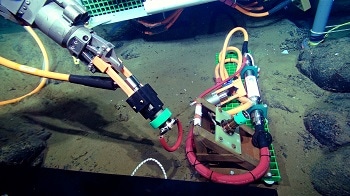Jul 29 2016
Teledyne Marine recently introduced the Electrical/Optical Flying Lead (EOFL), a compact, in-line media converter solution for subsea data transmission networks. The EOFL converts a fiber optic signal through a fiber optic wetmate connector, and produces an electrical Ethernet signal through an electrical connector on the other end.
 A remotely operated vehicle connects the Electrical/Optical Flying Lead to an
instrument node within the NEPTUNE observatory.
A remotely operated vehicle connects the Electrical/Optical Flying Lead to an
instrument node within the NEPTUNE observatory.
The conversion from optical to electrical is accomplished in a compact, 1- atmosphere internal pressure chamber that is rated to an exposure of up to 10,000 PSI external pressure. This technology allows data to be transmitted through deep water at lengths previously not possible with existing technology.
Ocean Networks Canada’s (ONC), NEPTUNE observatory is a 500-mile loop of fiber optic cables and sensing instruments off the west coast of British Columbia, Canada. Wet mateable interconnect, or flying leads, to transmit data from the instruments to a shore station is critical enabling technology.
ONC selected four units of the EOFL to connect two cable runs planned for the NEPTUNE cabled observatory. The two instrument locations are 1 mile and 2.4 miles from their primary junction boxes in over 7800 feet of water. Installation was successfully completed in June 2016, and the four units are performing with no issues.
Some very happy scientists are now receiving real-time data from new science sites as a result of the successful deployment.
Adrian Round, Director of Observatory Operations for ONC.
Ocean Networks Canada, an initiative of the University of Victoria, operates worldleading cabled ocean observatories that supply continuous power and Internet connectivity to a broad suite of subsea instruments from coastal to deep-ocean environments. Data from these observatories, and from ferries, gliders and moorings, fish tag receivers, and coastal radar, address pressing scientific and policy issues by providing long-term measurements of physical, chemical, biological, and geological aspects of the ocean during a critical time of climate change, ocean industrialization and increasing concern about marine hazards.
Research priorities include ocean change, developing forecasting and early warning systems for tsunamis, earthquakes and storm surge, deep-sea and arctic ecosystem studies, developing automated methods for analyzing ocean ‘big data’, and establishing marine science programs in coastal communities to build resilience to ocean change.
Teledyne Marine is a collaboration of 23 undersea technology companies assembled by Teledyne Technologies. In keeping with Teledyne’s philosophy, the organizations in the Marine group remain committed to their origins; however, they now join together to provide their collective customers with a new level of combined technology, innovation, and worldwide support. www.teledynemarine.com